Centauri Dreams
Imagining and Planning Interstellar Exploration
Unusual Planets in a Close Binary System
The three Alpha Centauri stars get more and more interesting as we begin to discover planets around them, and the hope of finding planets in the habitable zone around Centauri A or B continues to drive research. Alpha Centauri could be thought of as a close binary with a distant companion, since we’re still not absolutely sure whether Proxima Centauri is gravitationally bound to the system. Learning more about binary systems, in any case, is interesting in itself but also may open windows into our nearest stellar neighbors.
Thus the discovery of planets in the binary system HD 87646 draws my attention. Here we have a primary star, HD 87646A, about 12 percent more massive than the Sun that is some 22 AU away from another star, HD 87646B, the latter about 10 percent less massive than the Sun. Translated into local terms, that would be something like having another star at about the distance Uranus is in our Solar system.
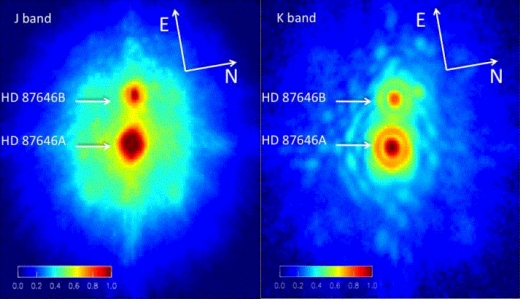
Image: The HD 87646 system, seen here in adaptive optic imaging from Palomar Observatory. Credit: Jian Ge/Bo Ma.
Compared to the Alpha Centauri system, the numbers are close. Centauri A and B orbit a common center of mass, separated by an average distance of 23.7 AU. But this is a highly elliptical orbit, with the average encompassing a swing between 36 AU and a close 11.4 AU, the latter not much farther than Saturn in our system. Proxima Centauri’s separation is wide, some 15000 AU plus or minus 700. If it is indeed bound to Centauri A and B, its orbital period is on the order of half a million years.
We learn in new work from Jian Ge (University of Florida) and postdoc Bo Ma that the HD 87646 binary contains planets, and unusual ones at that. MARVELS-7b (the name stands for Multi-object APO Radial Velocity Exoplanet Large-area Survey, a part of the Sloan Digital Sky Survey-III program) is 12 times the mass of Jupiter. A second world, MARVELS-7c, is 57 times Jupiter’s mass. We’re right on the edge here between giant planet and brown dwarf. Both these massive objects orbit the primary star at 0.1 and 1.5 AU respectively.
These are worlds that would have had to accumulate far more dust and gas than the kind of circumstellar disks we’re familiar with can offer, an indication that they must have formed through a different mechanism. The systems’ stability also raises questions about the formation process. One possibility considered in the paper is that the two planets formed as stars with their hosts, the result of the fragmentation of a large molecular cloud into four pieces. But the authors doubt that fragmentation on such a small scale can occur.
But if the paper casts doubt on the fragmentation model above, it also doubts the core accretion model, in which the gradual buildup of a planetary core pulls in gas from the circumstellar disk. In the HD 87646 system, forming two massive objects through core accretion would require a disk more massive than is usually found in close binaries.
That leaves disk instability as the formation model. Here gas in a high mass disk collapses quickly to form gas giant planets or, in this case, a possible brown dwarf. While core accretion models demand million year timeframes, disk instability can produce a planet within a few thousand years, assuming a circumstellar disk could cool quickly enough to create a bound object that continues to condense. The method can help us understand how massive planets could form at large distances from their star. But can it help us in a close binary situation?
The process is problematic for HD 87646:
Considering the primordial disk mass should be a lot more massive than the planet and brown dwarf mass, the disk is likely to be gravitationally unstable throughout the disk. This is consistent with gravitational instability leading to planet formation. Although several advantages exist for the disk instability model, we consider that such an explanation for the formation of the HD 87646 system should be taken with caution because whether disk instability can be triggered in the present of a close stellar companion remains an issue under debate…
Exactly so, and we also need to learn how the giant planet MARVELS-7b moved into its current low eccentricity orbit. The authors make the case that the planet formed in the disk and migrated inward to its current position, while the brown dwarf (MARVELS-7c) moved because of gravitational interactions in the system to a higher eccentricity orbit. The complexity of the interaction between other objects in the system and the smaller of the two binary stars leads the authors to call for future Gaia observations to constrain these orbits.
We’re left with disk instability as the best formation candidate, while conceding that HD 87646 still has secrets we need to unravel. On a broader front, it’s interesting to note that this work marks the eleventh detection of substellar companions in a binary system with separations of about 20 AU. We have no such detection for Centauri A or B and have to remove the putative world Centauri Bb from this list, but the remaining systems are all going to help us make sense of what we see in our stellar neighbors. HD 87646 is the first multiple planet system detected in binaries as close as this, but we can assume we’ll soon be adding to the catalog.
The paper is Bo Ma et al., “Very Low-Mass Stellar and Substellar Companions to Solar-like Stars From MARVELS VI: A Giant Planet and a Brown Dwarf Candidate in a Close Binary System HD 87646,” Astronomical Journal Vol. 152, No. 5 (7 October 2016). Abstract / preprint.

Ring Formation: Clues from the Late Heavy Bombardment
Let’s circle back this morning to ring systems, which were the subject of Monday’s post. In particular, I was interested in new work on the rings of Uranus, for Voyager data, newly analyzed, has revealed patterns that indicate the presence of small ‘shepherding’ moons. We’ve seen the same phenomenon at Saturn, but what similarities exist between the two ring systems also highlight their differences. The rings of Uranus — and this holds for Neptune as well — are much darker than the rings of Saturn, which are mostly made up of icy particles.
Darker rings, so the thinking goes, are a likely indication of higher rock content. But why are these ring systems so different, and what produced them in the first place? We have another new paper on the outer systems’ rings to throw into the mix from Ryuki Hyodo (Kobe University), working with co-authors at the Université Paris Diderot and Tokyo Institute of Technology. The team developed computer simulations to construct a plausible model for ring formation that takes us back 4 billion years to the era of the Late Heavy Bombardment (LHB).
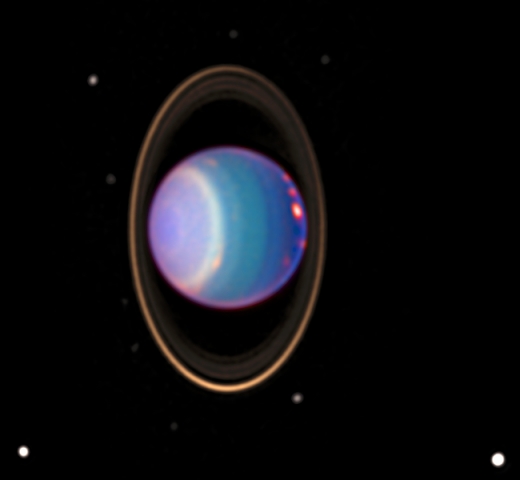
Image: A Hubble Space Telescope view reveals Uranus surrounded by its four major rings and by 10 of its 17 known satellites. This false-color image was generated by Erich Karkoschka using data taken on August 8, 1998, with Hubble’s Near Infrared Camera and Multi-Object Spectrometer.
The LHB was a time when numerous objects collided with planets in the inner system, and the Nice model, developed to explain the sudden spike in impactors, postulates that the giant planets were undergoing orbital migration at this time. That would disrupt scattered objects in the Kuiper Belt and the main asteroid belt, driving them into the inner system. It’s an attractive theory for Hyodo and team because their work calculates the probability of large objects from the Kuiper Belt passing close enough to the giant planets to be destroyed by tidal forces.
You can see where this is heading. It turns out that Saturn, Uranus and Neptune all would have had encounters with numerous objects large and small during any phase of planetary migration. Encounters with Pluto-sized objects, according to the paper, would have ranged from just a few up to several tens of encounters within each planet’s Roche limit during the Late Heavy Bombardment. The Roche limit describes the closest distance from the center of a planet that a small body can approach before being pulled apart by gravitational forces.
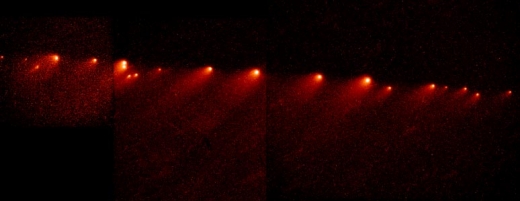
Image: What happens when an object gets too close to the Roche limit. This is comet Shoemaker Levy 9, seen here after fragmentation by Jupiter in 1992. The comet would go on to impact Jupiter in 1994. Credit: NASA/HST.
The team’s computer simulations then probed the question of what would happen to kilometer-sized fragments from these passing objects, the kind produced by tidal disruption. The scientists used supercomputers at the National Astronomical Observatory of Japan to show that such captured fragments would undergo repeated, high-speed collisions that would pulverize them over time, grinding them down into centimeter to meter sized particles of the sort currently seen in Saturn’s rings. In the process, their orbits would be circularized. The authors believe enough combined mass exists to explain the formation of ring systems.

Image: Schematic illustration of the ring formation process. The dotted lines show the distance at which the giant planets’ gravity is strong enough that tidal disruption occurs. (a) When Kuiper Belt objects have close encounters with giant planets, they are destroyed by the giant planets’ tidal forces. (b) As a result of tidal disruption some fragments are captured into orbits around the planet. (c) Repeated collisions between the fragments cause the captured fragments to break down, their orbit becomes gradually more circular, and the current rings are formed (partial alteration of figure from Hyodo, Charnoz, Ohtsuki, Genda 2016, Icarus).
The simulations offer a mechanism to explain why the rings of Saturn, Neptune and Uranus appear to have a different composition. The answer has much to do with the higher density of Uranus and Neptune compared to a much lower density Saturn. The case of Uranus explains how density factors into the formation scenario:
…due to its higher density, the width between [Uranus’] surface and its Roche limit is larger than in the case of Saturn. Thus, a body can pass deeper [into the] potential field of the planet. As a result, the tidal destruction could be significant enough to disrupt not only the body’s icy mantle but also its silicate core, and thus silicate components can be more efficiently captured than in the case of Saturn. This would also be applicable to Neptune since it is also denser than Saturn. Therefore, this could explain the fact that the rings of Uranus and that of Neptune are darker than that of Saturn.
In other words, a Kuiper Belt object with a rocky core and an icy mantle can be completely disrupted by a close pass of either Uranus or Neptune because of their higher density, with the rocky core destroyed and captured into what will become the ring structure. Objects approaching Saturn are likely to shed their icy mantle, but not necessarily their rocky core — the core in this scenario might go on to collide with the planet itself.
Hyodo’s model produces initially massive rings around all the giant planets, with the paper commenting that the diversity of rings seen today is clearly the result of subsequent evolution. The authors speculate only briefly on later ring evolution, leaving the matter to future work.
The paper is Hyodo et al., “Ring formation around giant planets by tidal disruption of a single passing large Kuiper belt object,” published online by Icarus 29 September 2016 (abstract / preprint).

Untangling the Effects of the ‘Big Whack’
Seasonal change on our planet is relatively moderate because the Earth has a small axial tilt. Just how that situation arose makes for interesting speculation, and a series of scientific papers that have been augmented by a new analysis in Nature from Matija ?uk (SETI Institute) and Sarah Stewart (UC-Davis). Working with colleagues at Harvard and the University of Maryland, the scientists have created computer simulations showing that the early Earth experienced a day as short as two hours, and had a highly tilted spin axis.
How we get from there to here is the question, and it’s one that ?uk and company answer by examining the collision that spawned Earth’s Moon. The impact theory sees the Moon forming from the debris of the collision between an infant Earth and a Mars-sized protoplanet.
It was ?uk and Stewart who suggested some four years ago that following the ‘Big Whack,’ the Earth’s rotation period was closer to two hours than the five that earlier work had suggested. The Moon would have formed much closer to the Earth than it is today, with the Earth losing much of its spin and a good deal of its tilt as the Moon’s orbit widened.
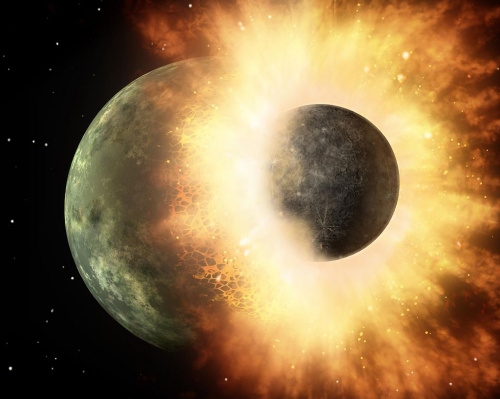
Image: Artist’s depiction of a collision between two planetary bodies. Such an impact between the Earth and a Mars-sized object likely formed the Moon. Credit: NASA/JPL-Caltech.
All this fits with what we see today, with the Moon continuing to move gradually away from the Earth as our planet’s spin continues to slow. The slowdown is produced by the tides the Moon raises on our surface, which dissipate energy continually as they interact with the oceans.
If we assume a fast spinning early Earth, the ejection of material following the impact can produce a Moon similar in composition to Earth’s mantle, which is what we see in lunar rocks. Now we get into the realm of orbital interactions that determine the system’s evolution. For today’s Moon has a tilt of its own, about five degrees off from Earth’s orbital plane. This is true despite the likelihood that internal friction due to tidal effects by the Earth should have had a profound effect on the Moon’s tilt, decreasing it over a billion-year time frame.
The tilt of the Moon’s orbit, in other words, must have once been much greater than it is today. ?uk, Stewart and colleagues Douglas Hamilton (University of Maryland) and Simon Lock (Harvard) believe we can arrive at today’s situation if we begin with an Earth that, not long after the impact, was spinning essentially on its side, with the Moon orbiting the equator. With an axial tilt of over 70 degrees, this situation will not last, with solar gravitational forces creating an eccentricity in the Moon’s orbit that produces strong tidal flexing within it.
These internal lunar tidal effects, in the view of the scientists, would have produced a counter-force against the tidal effects from the Earth that would have been pushing the Moon into a wider orbit. During this period, Earth would have continued to lose its spin, but rather than going into a wider orbit, the Moon’s orbit would have become increasingly tilted.
It would only be as the Earth’s rotation continued to slow that the Moon could break out of this deadlock and continue moving away from our planet. Its subsequent torque on the Earth’s spin axis is what ?uk and team believe began to move the Earth’s axial tilt into more moderate territory. And tidal flexing inside the Moon would have helped to shrink its orbital inclination, so that today it is within five degrees of the orbital plane of the planets.
The paper summarizes the situation, with interesting exoplanet implications. Note the reference in the passage below to the ‘Cassini state,’ which is a system that obeys the laws of the Moon’s motion with respect to the Earth that were originally stated by the Italian astronomer Giovanni Domenico Cassini (for whom our Saturn orbiter is named):
Our high-obliquity model is at present the only model we are aware of to explain the origin of large past lunar inclination, which was subsequently reduced by strong obliquity tides at the Cassini state transition… [O]ur results support high-AM [angular momentum] giant-impact scenarios for lunar origin. An initially high-obliquity Earth is consistent with the expectation of random spin-axis orientations for terrestrial planets after giant impacts, and the dynamics discussed here naturally reduces Earth’s obliquity to values that are low to moderate.
Which is interesting indeed, because here we have a mechanism that can gradually bring a high obliquity exoplanet to a much lower axial tilt, thereby making moderate seasons possible. Is a large moon critical for planetary habitability? ?uk comments on the same point:
“This work shows that there are multiple ways a planet could get a small axial tilt, making moderate seasons possible. We thought Earth was this way because of the direction of the giant impact 4.5 billion years ago, but it looks like Earth achieved this state later through a complex interaction with the Moon and the Sun. I wonder how many habitable Earth-like extrasolar planets also have a large Moon.”
Centauri Dreams’ take: Interacting gravitational influences within the Solar System have a great deal to do with habitability, as the work of the Serbian astronomer Milutin Milankovi? has demonstrated. Milankovi? (working while a prisoner of war during World War I) found rhythmical climate cycles that deep sea core analysis confirmed in the 1970s, all related to gravitational nudges involving the motions of Jupiter, Saturn and the Moon.
David Grinspoon writes about Milankovi? in his fine new book Earth in Human Hands (2016), pointing out that while our Moon has kept Earth’s rotational axis stable at a 23.5 degrees tilt from the Sun, Mars (currently at about 25 degrees of tilt) varies from 15 to 35 degrees and sometimes more over a period of 120,000 years. Rhythmical climate torques also show up on Titan. Clearly such interactions will have to be taken into account as we examine young systems around other stars and their likely evolution.
The paper is ?uk, “Tidal evolution of the Moon from a high-obliquity, high-angular-momentum Earth,” published online by Nature 31 October 2016 (abstract).

Uranus: New Work from Voyager Data
The ring system of Uranus was the second to be discovered in our Solar System. You would assume this came about because of Voyager, but the discovery was actually made in 1977 through ground-based observations involving occultations of distant stars. The rings of Uranus are narrow — between 1 and 100 kilometers in width — and many are eccentric. The fact that they are composed of dark particles makes detection and study particularly difficult.
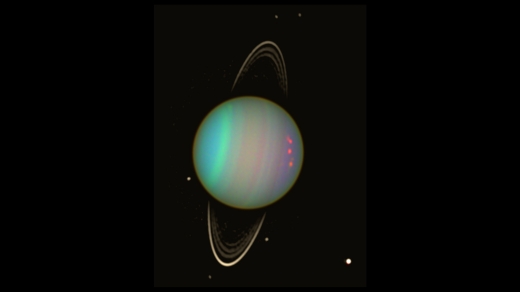
Image: Uranus is seen in this false-color view from NASA’s Hubble Space Telescope from August 2003. The brightness of the planet’s faint rings and dark moons has been enhanced for visibility. Credit: NASA/Erich Karkoschka (Univ. Arizona).
Voyager 2’s flyby of the planet in January of 1986 gave us useful information about the rings’ structure, with three occultation experiments performed during the flyby. We learned that the moons Cordelia and Ophelia were helping to shape the eccentricity of some of the rings (deviations of tens to hundreds of kilometers in some cases). The two moons, in other words, were acting as ‘shepherd’ satellites for three of the planet’s nine rings (?, ? and ?).
In a new paper, Rob Chancia (University of Idaho), working with colleague Matt Hedman, revisits the Voyager cache to tease out further patterns in the ring data. In particular, the amount of material on the edge of the Uranian ? ring, one of the planet’s brightest, varies periodically, a pattern that also turns up in the neighboring ? ring. “When you look at this pattern in different places around the ring, the wavelength is different — that points to something changing as you go around the ring. There’s something breaking the symmetry,” says Hedman, recognizing a pattern not dissimilar from similar structures around Saturn.
Narrow rings are themselves signs of some kind of perturbation. The authors argue that a ringlet left unperturbed will spread out radially because of particle collisions, on timescales as small as several thousand years, assuming rings the size of the Uranian ? and ? rings. A small moon that confines the edges of the ring should produce structures in the form of wavy edges and wakes, and indeed, variations like these clued scientists to the position of Saturn’s moon Pan in Voyager 2 images.
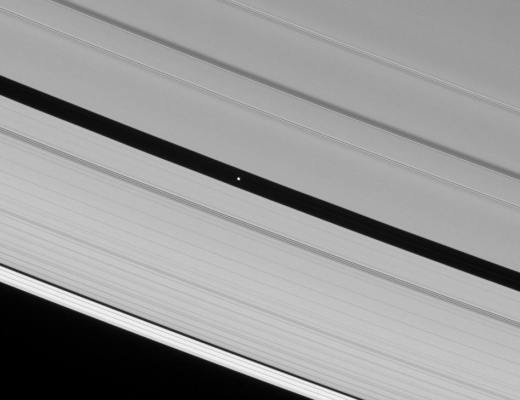
Image: Shepherding Saturn’s rings. The Cassini spacecraft spies Pan speeding through the Encke Gap, its own private path around Saturn. Illumination is from the lower left here, revealing about half of Pan (26 kilometers across) in sunlight. Credit: NASA.
The Voyager data Chancia and Hedman use in this paper were produced by experiments with the spacecraft’s Radio Science Subsystem (RSS), which transmitted at microwave wavelengths (in the X band at 3.6 cm and in the S band at 13 cm) through the rings to ground stations on Earth. Other Voyager data through two other instruments were also acquired but lacked the precision to examine the rings for the presence of perturbing moonlets.
If the same phenomenon we see in Saturn’s rings is happening at Uranus, the Voyager data aren’t sensitive enough to show the culprits, but Chancia and Hedman think that similar moonlets, between 4 and 14 kilometers in diameter, could be keeping the Uranian rings narrow.
From the paper:
Our attempts to visually detect the moonlets are not exhaustive, but given the small predicted sizes of the ? and ? moonlets, a convincing detection may not be possible in the Voyager 2 images. Future earth-based observations may be more likely to detect these moons. Regardless of the current lack of visual detection, the identification of these periodic structures in the outer regions of the ? and ? rings is evidence of interactions with nearby perturbers.
How the rings of Uranus stay this narrow is a problem that has vexed scientists since 1977, but we may be teasing out the solution in data that are not a great deal younger. If Voyager 2 continues to pay off in terms of new planetary insights (not to mention both Voyagers’ continuing push into the outer Solar System), it’s a reminder that missions like New Horizons are likely to be producing discoveries for many years now that the data download is complete. I’m also reminded of how much new data we’ll acquire from Cassini when it makes its first ‘dive’ through the planet/ring gap on April 27 of next year. Thanks to Cassini, this is one ring system we can see up close, illuminating the systems around the other outer worlds.
The paper is Chancia and Hedman, “Are there moonlets near Uranus’ alpha and beta rings?” accepted for publication in the Astrophysical Journal (preprint).

New Clue to Gas Giant Formation
Just how do gas giant planets form? A team of researchers at ETH Zürich, working with both the University of Zürich and the University of Bern, has developed the most fine-grained and instructive computer simulations yet to help us understand the process. Using the Piz Daint supercomputer at the Swiss National Supercomputing Centre (CSCS) in Lugano, ETH Zürich postdoc Judit Szulágyi and Lucio Mayer (University of Zürich) can now show clear and observable differences between the two formation processes under study by theorists.
The core accretion model begins with a massive solid core that is large enough to pull in gas from the protoplanetary disk and maintain it. The gravitational instability theory, on the other hand, presumes a massive enough disk around the young host star that spiral arms form in the disk in which gravitational collapse can occur around material that has begun to clump there. The simulations demonstrate that with either formation mechanism, a circumplanetary disk forms around the young gas giant planet out of which satellite systems can emerge.
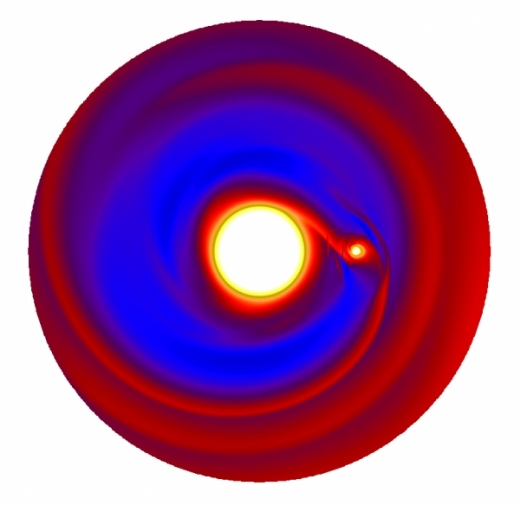
Image: Core accretion: A 10 Jupiter-mass planet is formed and is placed at 50 AU from the star. The planet has opened a gap in the circumstellar disk. (Image: J. Szulagyi, JUPITER code).
The circumplanetary disk forming around the young planet in the last phase of giant planet formation is central to this work. The disk eventually gives birth to the planet’s moons, while also regulating the accretion of gas as the planet forms. The authors refer to such a subdisk as a circumplanetary disk. In both theories of planet formation, such disks form within the larger circumstellar disk out of which the rest of the planetary system will grow. We have not yet observed circumplanetary disks, which is why the realm of simulation is so important.
The supercomputer simulations take us into new territory in modeling these processes, demonstrating a major difference between the two formation mechanisms: temperature. Create a gas giant with disk instability and you wind up with gas near the planet remaining in the 50 Kelvin range, much colder that what emerges in core accretion, where the disk around the emerging planet is heated to hundreds of Kelvins. The simulations, according to Mayer, used tens of millions of resolution elements, marking the first time the formation of a circumplanetary disk has been simulated around protoplanets at this level of detail.
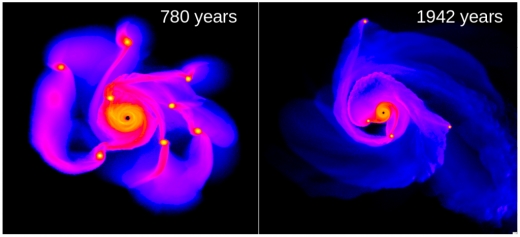
Image: Gravitational instability simulation: Two snapshots in the early and late stage of the simulation at 780 years and 1942 years. The second snapshot shows only 4 clumps remaining among those initially formed. (Image: Lucio Mayer & T. Quinn, ChaNGa code).
Here we have effects that are observable, allowing astronomers to examine newly forming planetary systems to measure the temperatures that will indicate which formation process built the planet they observe. From the paper:
…our finding is that the temperature differs by more than an order of magnitude between the GI [gravitational instability] and CA [core accretion] formed CPDs [circumplanetary disks]. According to the simulations, the bulk subdisk temperature is < 100 K in the case of disk instability, and over 800 K for all the CA computations presented in this paper. The reason for this discrepancy lies in the different gravitational potential wells and opacities. Because the protoplanet is a few AU wide extended clump in the GI simulations, while it is a fully formed giant planet with a radius of 0.17 AU (meaning the gravitational potential smoothing length) in the CA-1 simulation, the accreted gas has significantly more energy to release into heat in the latter case than in the former.
Direct imaging of young gas giants can be deceptive, because as the second of two papers on this work points out, a shock front developing in the circumplanetary disk can be luminous and extended, masking the luminosity of the protoplanet itself as it forms beneath the disk. The shock front is created as accreted gas from the outside falls into the gap between the disk’s upper layers and the surface of the disk and the polar regions of the protoplanet.
“When we see a luminous spot inside a circumplanetary disk, we cannot be sure whether we see the planet luminosity, or also the surrounding disk luminosity,” says Szulágyi. This can cause us to estimate a planet’s mass as being up to four times higher than it actually is.
But the variation in temperature between core accretion and gravitational instability models makes it clear that what is happening in these circumplanetary disks can help us distinguish between the formation mechanisms of the planets in question. Measuring temperatures near the planet will allow astronomers to tell which formation process built the planet.
No differences in circumplanetary disk mass were found between the two formation scenarios, a finding that contradicted earlier theoretical models. Even so, although the supercomputer simulations were intensive, the researchers point out that simulations of disk instability do not cover a long enough timescale. Future simulations will have to extend that range while also looking at ionization and the effects of magnetic fields, not accounted for in this work.
The papers are Szulágyi, Mayer & Quinn, “Circumplanetary disks around young giant planets: a comparison between core-accretion and disk instability,” accepted at Monthly Notices of the Royal Astronomical Society (preprint); and Szulágyi and Mordasini, “Thermodynamics of Giant Planet Formation: Shocking Hot Surfaces on Circumplanetary Disks,” accepted at MNRAS Letters (preprint).

A Renewed Look at Boyajian’s Star
It was inevitable that KIC 8462852 would spawn a nickname, given the public attention given to this mystifying star, whose unusual lightcurves continue to challenge us. ‘Tabby’s Star’ is the moniker I’ve seen most frequently, but we now seem to be settling in on ‘Boyajian’s Star.’ It was Tabetha Boyajian (Louisiana State) whose work with the Planet Hunters citizen science project brought the story to light, and in keeping with astronomical naming conventions (Kapteyn’s Star, Barnard’s Star, etc.), I think the use of the surname is appropriate.
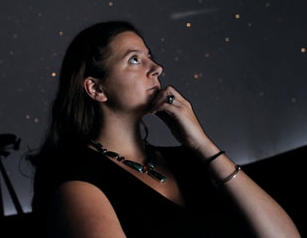
Planet Hunters works with Kepler data, looking for any dimming of the 150,000 monitored stars that may have gone undetected by the automated routines that hunt for repeating patterns. Boyajian’s Star cried out for analysis, dimming in odd ways that flagged not the kind of planetary transit across the face of a stellar disk that researchers expected but something else, something that would make the star dim by as much as 22 percent, and at irregular intervals. That led to a variety of hypotheses, the best known of which is a large group of comets, but we also have evidence that the star has been dimming at a steady rate.
Image: Tabetha Boyajian, looking up, presumably at Boyajian’s Star (caption swiped from Jason Wright’s page at Penn State).
With the story this unsettled, this morning’s energizing news is that Boyajian’s Star is now being examined by Breakthrough Listen. Working with Jason Wright, now a visiting astronomer at UC Berkeley, as well as Boyajian herself, the SETI project intends to devote hours of listening time on the Green Bank radio telescope in West Virginia to the star. You’ll recall that Breakthrough Listen is the $100 million SETI effort funded by the Breakthrough Prize Foundation and its founder, investor Yuri Milner. The Breakthrough Starshot project described often in these pages is also a Breakthrough Prize Foundation initiative.
As Andrew Siemion (director of the Berkeley SETI Research Center and co-director of Breakthrough Listen) explains in the video above, the project has access to the most powerful SETI equipment available, meaning its scientists can study Boyajian’s Star at the highest levels of sensitivity across a wide range of possible signal types. But the Green Bank effort will hardly be the first, for Boyajian’s Star has already excited a great deal of interest, as Siemion explains:
“Everyone, every SETI program telescope, I mean every astronomer that has any kind of telescope in any wavelength that can see Tabby’s star has looked at it. It’s been looked at with Hubble, it’s been looked at with Keck, it’s been looked at in the infrared and radio and high energy, and every possible thing you can imagine, including a whole range of SETI experiments. Nothing has been found.”
In Green Bank, Breakthrough Listen has access to the largest fully steerable radio telescope on the planet. Observations are scheduled for eight hours per night for three nights in the next two months, the first having taken place on October 26. The plan is to gather as much as 1 petabyte of data over hundreds of millions of individual radio channels. Siemion describes a new SETI instrument that can examine “…many gigahertz of bandwidth simultaneously and many, many billions of different radio channels all at the same time so we can explore the radio spectrum very, very quickly.”
Breakthrough Listen will be observing using four different radio receivers on the Green Bank instrument in a frequency range from 1 to 12 GHz, a range beginning, Siemion says, at about where cell phones operate up through the frequencies used for satellite TV signals.
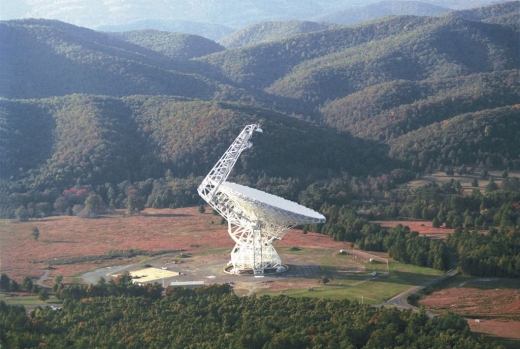
Image: The Green Bank Radio Telescope (GBT) focuses 2.3 acres of radio light. It is 148 meters tall, nearly as tall as the nearby mountains and much taller than pine trees in the national forest. The telescope is in a valley of the Allegheny mountains to shield the observations from radio interference. Credit: NRAO/AUI.
Yesterday’s live video chat from Green Bank with Tabetha Boyajian, Jason Wright and Andrew Siemion is now available online, with the trio answering questions about the ongoing study. Boyajian was asked as the session opened how many comets it would take to reproduce the effects being observed around KIC 8462852. The answer: Hundreds to thousands of “very giant comets” just to reproduce the last 30 days of the data.
The numbers give no particular credence to the idea that we may be looking at some kind of artificial construction project around Boyajian’s Star, but they do underline how mysterious are the processes, assuming they are natural, that are driving this phenomenon. Boyajian called the comet hypothesis ‘pretty outrageous,’ but went on to say that of all the explanations, it is the one she most favors, as all other explanations are likewise outrageous.
On that score, I want to mention Jason Wright’s paper, written with Steinn Sigurðsson at Penn State, looking at other possible solutions to the Boyajian’s Star puzzle. It’s particularly useful early on in a section devoted to the follow-up work that has occurred, including the SETI studies with the VERITAS gamma-ray observatory, the Allen Telescope Array and the Boquete Optical SETI Observatory, but also reprising the interesting controversy over the dimming of the star. If you need to catch up with Boyajian’s Star, this is the place.
Wright and Sigurðsson conclude that long-term dimming would not fit well with the comet hypothesis, leaving us still searching for an answer. What does work its way up the chain of plausibility? An unusually dense region of the interstellar medium or a chance alignment with a localized molecular cloud occurring between us and the star is in the mix. The latter might be a so-called ‘Bok globule,’ an isolated and dark nebula dense with dust and gas.
The comet hypothesis is still in play, but a number of other explanations are problematic:
Less compelling, but difficult to rule out, are intrinsic variations due to spots, a “return to normal” from a temporary brightening (due to, perhaps, a stellar merger) and a cloud of material in the outer solar system. We find instrumental effects, other intrinsic variation in Boyajian’s Star, and obscuration by a disk around an orbital companion to Boyajian’s Star very unlikely to be responsible.
Read the paper for the entire list, which includes, with plausibility listed as unclear, the idea of artificial structures (“Would find support if all natural hypotheses are ruled out, we detect signals, or if star suffers significant achromatic extinction.”) The paper is Wright and Sigurðsson, “Families of Plausible Solutions to the Puzzle of Boyajian’s Star,” accepted at the Astrophysical Journal (preprint). But see also Jason Wright’s 10-part popular summary on Boyajian’s Star, which goes through all the options.


